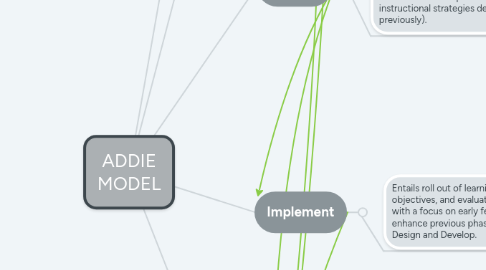
1. Analyze
1.1. Set instructional objectives and understand learner's current skill set/gaps.
1.1.1. 1. Determine the Instructional Goals [desirable learning outcome(s)]
1.1.2. 2. Instructional Analysis: how to execute the instructional goals (determine tools and resources required)
1.1.3. 3. Analyze the Learner and their current level of expertise to determine how much content is required. What are learner expectations? Preference for learning?
1.1.4. 4. Learning Objectives: What should the learner be able to understand/execute/acquire upon the completion of the course?
2. Design
2.1. Entails how learning objectives identified in Analysis will be mapped out or broken down. The Design Phase answers will the learning be in segments? What will the objective of each segment be? How will the learning content be delivered? How will the learning be assessed?
2.1.1. 1. Design Assessments (how will you assess that the knowledge, skill, or ability is obtained by the end of the course). Consider items from analysis phase above; goals, learner characteristics, context, and instruction
2.1.2. 2. Select Course Format "how you will teach learners". Examples via classroom, self-paced, blended, or e-learning.
2.1.3. 3. Create Instructional Strategy (content delivery); i.e. how will the learners understand content. Strategies include worksheets, lectures, readings, group activities, assessments.
2.1.3.1. Dick, Carey & Carey outline 5 major learning components when building out instructional strategy as follows: pre-instructional activities (how to motivate learners and do they understand course objectives), content presentation (content should be to the point and example based), learner participation (allowing learners to practice with real time feedback), assessment (practice assessments) and follow through activities (review of course strategy and how to apply learning in real life upon course completion)
3. Develop
3.1. Develop Content or learning materials to support the learning objectives identified in Analysis and Design Phases. Subject Matter Experts (SME's) may be leaned on for content development (build out the instructional strategies determined previously).
3.1.1. 1. Develop instructional materials, e-learning, lectures etc.... Gather feedback from client or Subject Matter Experts to ensure content aligns to goals from first two phases.
3.1.2. 2. Conduct timed Run-Through/pilot of learning created with a feedback loop from SME's and learners to enhance the design of content along the way.
4. Implement
4.1. Entails roll out of learning curriculum, objectives, and evaluation procedures with a focus on early feedback to enhance previous phases of Analysis, Design and Develop.
4.1.1. 1. Ensure the Instructor has been trained on the new learning material or curriculum & understands their role in the curriculum roll out.
4.1.2. 2. Ensure the Learners have access and know how for the learning technology, and understand the learning objectives/curriculum.
4.1.3. 3. Ensure learning space is arranged, materials are ordered (if required) and media is tested in advanced.
4.1.4. 4. Obtain feedback from Trainers & Learners and loop back to fine tune the Analysis, Design and Development Phases to close any gaps or perfect.
5. Evaluate
5.1. This step is conducted throughout the ADDIE process to determine success in achieving instructional goal in the Analysis phase. Are there any gaps that need to be addressed or issues that arose as a result of the implementation. There are 2 types of evaluation; formative and summative.
5.1.1. Formative evaluation takes place throughout the ADDIE Model. There are 3 stages: 1. One/one (ask about effectiveness of learning was it clear? what was the impact? was it practical/realistic?) and use feedback to enhance other phases of ADDIE to fine tune. 2. Small group evaluation to further refine 3. Conduct a field trial/pilot roll out with final feedback survey to make any final changes.
5.1.2. Summative: prove the worth of the instruction after course implementation. 1st evaluate reaction of learner (clarity of learning, instructors approach to learning/methods). 2nd evaluate learning (evaluate learners success through course through assessments). 3rd evaluate behavior has the learning resulted in a change in behavior if that was the objective. Lastly, evaluate impact of learning on results (is the learner more productive?).
